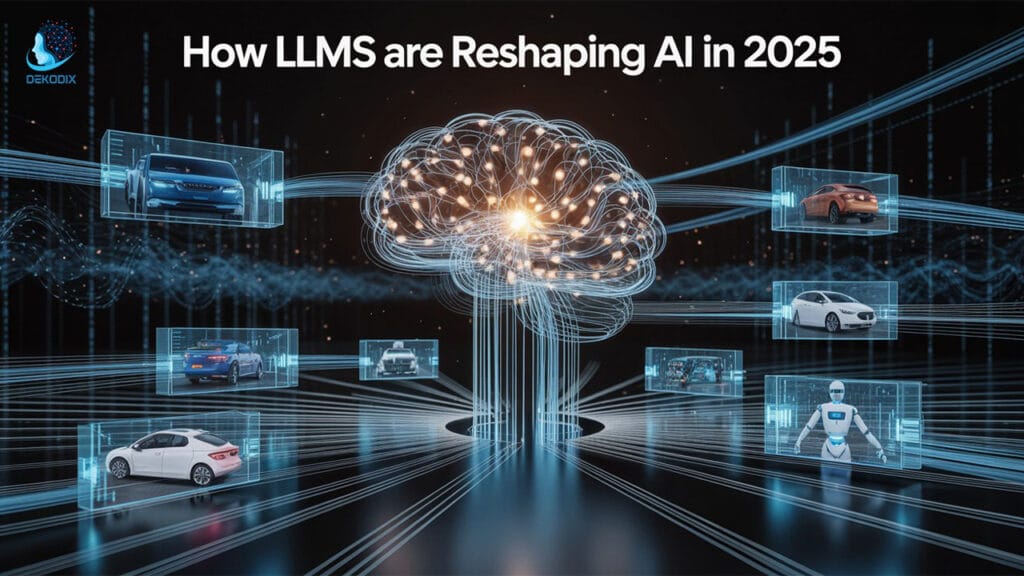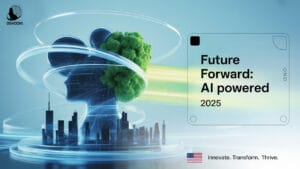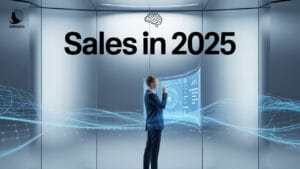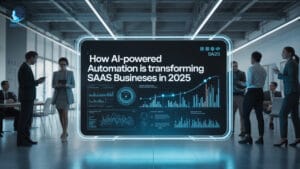Introduction: Understanding the Evolution of LLMs
The Shift from Statistical to Generative Models
Language models have evolved rapidly from simple rule-based systems to complex, context-aware generators of text. Early systems depended on manually coded rules and statistical probabilities, offering limited flexibility and poor scalability. With the rise of machine learning, language models began learning from data, identifying patterns, and improving their linguistic outputs. This evolution paved the way for more advanced natural language processing tools that could not just understand, but also generate human-like responses. By 2025, LLMs are no longer niche academic tools; they’re integrated into everyday workflows, customer service bots, content generation engines, and decision support systems.
Why LLMs Matter More Than Ever
In today’s AI-first world, large language models (LLMs) have become foundational technologies. They power intelligent virtual assistants, automate repetitive writing tasks, enhance education, and provide cognitive insights in fields like healthcare and law. The sophistication of LLMs enables them to understand tone, sentiment, and complex context, often rivaling human-level interpretation. Their ability to scale and personalize communication has profound implications for businesses and individuals alike. As reliance on them grows, so does the need to understand their evolution, capabilities, and risks. Recognizing where LLMs came from, and where they’re headed, is vital for professionals across every sector.
The Core Mechanics Behind LLMs
LLMs function by analyzing vast corpora of text data, learning to predict the next word in a sentence, and understanding contextual patterns. They employ techniques like tokenization, attention mechanisms, and deep learning to build accurate language representations. What separates today’s LLMs from earlier models is their scale of billions of parameters trained across diverse datasets. These models learn grammar, knowledge, and reasoning not through programming but through exposure. However, their capabilities are bounded by their training biases in data or gaps in context that can skew output. Hence, refining architecture and training practices remains crucial to the technology’s continued success.
Setting the Stage for 2025
As we approach 2025, LLMs are crossing new frontiers in interaction, reasoning, and multimodal comprehension. The evolution is no longer about improving response accuracy but redefining what AI can do: self-correcting, teaching itself new skills, and integrating seamlessly across formats text, audio, video. From GPT-3 to GPT-4 and beyond, each iteration has added sophistication and new use cases. The next generation of LLMs will be more autonomous, creative, and ethically grounded. Understanding their evolution helps individuals and organizations adapt, innovate, and remain competitive in a world where LLMs shape communication, business, and society.
From Rule-Based Systems to Neural Networks
Early AI: Rule-Based Systems
Before neural networks and deep learning, AI relied on hand-crafted rules. These rule-based systems followed “if-then” logic, which limited their ability to handle ambiguity or novel inputs. Language understanding was rigid, literal, and incapable of dealing with context shifts. These limitations made early systems brittle and impractical for natural conversations. Moreover, expanding them required manual intervention, making scalability a challenge. Despite their shortcomings, rule-based systems laid the groundwork for natural language understanding and inspired the need for more adaptive models. The limitations of this era helped define the next phase of innovation in language processing.
Statistical Models and the Dawn of NLP
The 1990s and early 2000s saw a shift to statistical models like n-grams and Hidden Markov Models. These approaches used probabilities and corpus frequency data to predict likely word sequences. It marked a significant improvement over rules but still lacked deep contextual understanding. Models were easily thrown off by long sentences or complex syntax. While these statistical methods powered early machine translation and search engines, they couldn’t handle nuanced conversation or multiturn dialog. However, they were essential steppingstones to more dynamic, data-driven approaches that would later redefine language AI through deep learning and neural computation.
Rise of Neural Networks
Neural networks introduced a flexible, learn-from-data approach to language modeling. By representing words as vectors and training models with layers of computation, these systems learned semantic relationships and syntactic patterns. Recurrent Neural Networks (RNNs) and Long Short-Term Memory (LSTM) architectures allowed models to understand sequence and memory. Though powerful, these models still struggled with long-range dependencies. Nonetheless, their impact on NLP was monumental; they improved translation, speech recognition, and named entity recognition tasks. Neural networks brought new levels of abstraction, enabling machines to “understand” rather than memorize. This formed the springboard for the transformer revolution that would soon follow.
Bridge to Modern LLMs
The journey from rule-based logic to deep neural networks represents a seismic shift in AI’s ability to comprehend human language. Neural networks not only improved task performance but fundamentally changed how models are trained, evaluated, and deployed. Their capacity to process and represent meaning made them ideal for scaling up language applications. These foundational innovations made modern LLMs possible by proving that machines could learn language patterns without explicit instruction. Understanding this trajectory highlights how far we’ve come and underscores the importance of innovation, architecture, and data in shaping the AI tools of tomorrow.
Technological Innovations Driving LLM Evolution
Transformer Architecture Advancements
The foundation of modern LLMs lies in transformer architectures, which continue to evolve rapidly in 2025. These models now boast enhanced attention mechanisms, allowing them to process longer contexts without losing accuracy. New variants like sparse transformers and retrieval-augmented transformers boost efficiency by focusing only on relevant information.
This leads to faster responses and reduced computational costs. Improvements in tokenization and embedding models further refine how LLMs understand nuances in language, slang, and emotion. The result is smoother, more context-aware interactions. Researchers now prioritize both model depth and parameter efficiency, making cutting-edge performance accessible even on limited hardware. This progress is critical as LLMs scale across devices from cloud systems to smartphones enabling widespread, real-time AI use. Ultimately, these innovations ensure LLMs remain scalable, sustainable, and smarter than ever before.
Multimodal Integration
In 2025, LLMs no longer process just text; they now understand and generate multiple forms of data, including images, audio, video, and code. Multimodal LLMs blend natural language with visual and auditory inputs, allowing users to query images, describe diagrams, and even edit media using prompts. For example, a doctor might input a chest X-ray and receive textual analysis from an LLM trained in radiology.
This convergence broadens application areas and enhances the user experience, particularly in education, healthcare, marketing, and content creation. Multimodal learning also brings context-rich insights and greater user accessibility, such as tools for visually impaired users or automatic sign language interpretation. The ability to process cross-domain information turns LLMs into true collaborators, understanding real-world complexities with human-like comprehension and enabling fluid interaction across all digital formats.
Energy Efficiency and Green AI
As LLMs grow in size, so do their energy demands raising concerns about environmental impact. In response, 2025 marks a strong shift toward energy-efficient AI. Innovations such as quantization, pruning, and model distillation help reduce computational costs without compromising output quality. Hardware accelerators like TPUs and AI-specific GPUs optimize power usage, while edge-computing solutions enable on-device inference to cut down data transmission.
Many organizations are adopting green AI practices, including training on renewable-powered data centers and measuring carbon footprints of model development. These practices aren’t just sustainable, they’re cost-effective and support corporate social responsibility goals. Researchers and developers now prioritize eco-conscious design as part of ethical AI standards, ensuring that LLM progress aligns with climate goals. Green LLMs are the future smart, scalable, and sustainable.
Open Source and Collaboration
The open-source community has significantly accelerated LLM development. In 2025, platforms like Hugging Face, OpenLLM, and Meta AI’s LLaMA foster collaborative innovation by sharing model weights, datasets, and benchmarks. This democratization of LLMs enables startups, students, and researchers from around the globe to experiment and build new solutions. Shared knowledge leads to faster breakthroughs, better security testing, and stronger global competition.
Additionally, community-driven models often emphasize transparency, reproducibility, and ethical standards addressing concerns often overlooked by proprietary systems. Major academic institutions now collaborate with open-source AI labs, offering education and certification programs in LLM engineering. These initiatives break down barriers and diversify the talent pipeline. In effect, the future of LLM evolution isn’t confined to tech giants, it’s a global, cooperative effort shaped by shared intelligence and open opportunity.
Challenges and Limitations in LLM Development
Cost and Accessibility
Despite rapid progress, the high cost of training and deploying large LLMs remains a major obstacle. In 2025, building a state-of-the-art LLM can require millions of dollars and significant infrastructure. While cloud providers offer scalable solutions, smaller businesses and academic institutions often struggle with affordability. Although open-source alternatives and model compression techniques help, access remains uneven.
As a result, there’s a growing divide between well-funded tech firms and independent developers. This digital gap limits innovation and raises concerns about AI monopolies. Equitable access to LLMs is essential for balanced global advancement. Solutions include AI-as-a-service platforms, funding for public AI research, and policies that promote inclusive participation. Democratizing access to LLMs isn’t just ideal, it’s necessary for ethical and scalable AI that serves all of humanity, not just a few.
Hallucinations and Factual Accuracy
One persistent issue in LLMs is their tendency to “hallucinate” producing information that sounds plausible but is incorrect or fabricated. In 2025, even top-tier LLMs still face challenges in distinguishing fact from fiction, particularly when handling complex queries or outdated datasets. This limits trust in critical applications like medicine, law, and finance. Developers combat hallucinations using retrieval-augmented generation (RAG), dynamic knowledge bases, and fact-checking APIs.
Still, the challenge remains unresolved. The line between creative generation and factual accuracy can blur, requiring users to maintain oversight and skepticism. LLMs should be treated as assistants, not authorities. By combining outputs with verified sources, organizations can reduce misinformation risks. Building AI systems that are both imaginative and accurate is key to their responsible use in real-world decision-making.
Language and Cultural Bias
LLMs trained on vast internet data often absorb and amplify cultural stereotypes, language biases, and exclusionary norms. In 2025, addressing these issues is a critical focus in AI development. Models may favor dominant languages like English, underperforming in regional dialects or minority languages. Similarly, they may reflect cultural perspectives skewed toward the West, marginalizing global viewpoints. Developers now curate training datasets to include diverse voices and conduct bias audits before deployment.
However, eradicating bias completely is difficult. Cultural sensitivity in LLMs is not only about fairness, it’s about functionality. A globally relevant AI must understand and respect the variety of human experiences. The goal isn’t perfection, but continuous improvement. Cultural inclusivity isn’t just ethical, it’s vital for the effectiveness of LLMs in a connected, multicultural world.
Model Interpretability
A major challenge in LLMs is their “black box” nature: users and even developers often struggle to understand how decisions are made. In 2025, interpretability is a hot topic. While models like GPT-5 or Claude 3 may offer high accuracy, their inner workings remain opaque. This raises problems in auditing, debugging, and ensuring reliability. Techniques like attention heatmaps, attribution models, and input-output tracing offer partial insights, but full transparency is elusive.
Explainability is especially important in sensitive sectors like healthcare, law, and governance, where accountability is mandatory. Developers are working on hybrid models that combine symbolic logic with neural networks to improve traceability. Trustworthy AI depends on visibility not just performance. Interpretability isn’t a technical afterthought, it’s a foundational requirement for secure and ethical LLM deployment.
Real-World Applications: LLMs in Action
Business Automation and Customer Service
LLMs have revolutionized customer support by enabling intelligent chatbots and virtual assistants to handle queries with speed and accuracy. In 2025, businesses automate routine workflows like data entry, invoice generation, and scheduling using LLM-powered agents. These models understand context, adapt to user tone, and even learn preferences over time, making interactions more human-like. As companies seek to enhance customer satisfaction and reduce costs, LLMs have become a critical tool for scaling without sacrificing quality. The ability to operate 24/7 and support multiple languages makes LLMs invaluable for global businesses.
Education and Personalized Learning
LLMs are transforming how we learn by delivering tailored educational content. Students receive real-time tutoring, while educators benefit from automated grading and curriculum planning. In 2025, LLMs create personalized lesson plans based on a learner’s pace, interests, and gaps in knowledge. They also simulate discussions, quizzes, and feedback loops to make education interactive. Educational platforms integrate LLMs to support inclusive and remote learning environments, democratizing access to knowledge. As LLMs grow more context-aware, they’re not just tools but collaborators in the learning process.
Healthcare and Clinical Decision Support
In healthcare, LLMs assist doctors by interpreting patient data, suggesting diagnoses, and even summarizing case histories. By processing clinical literature and patient records, they help reduce diagnostic errors and accelerate treatment planning. In 2025, LLMs are embedded in hospital systems, supporting triage, mental health consultations, and patient follow-ups. Their multilingual and multimodal capabilities allow them to interact with diverse patient populations. When integrated responsibly with medical oversight, LLMs boost healthcare efficiency, lower administrative burdens, and ultimately improve outcomes.
Legal, Research, and Financial Services
LLMs streamline contract analysis, case summarization, and risk assessment in legal and financial industries. In 2025, law firms and financial institutions leverage these models for due diligence, fraud detection, and regulatory compliance. Researchers use LLMs to process academic papers, summarize findings, and generate citations. These tools drastically reduce time spent on repetitive tasks while ensuring precision. With continuous fine-tuning, LLMs now understand legal jargon, financial trends, and academic formatting, empowering professionals to focus on strategy and innovation rather than grunt work.
Ethical Considerations and Responsible Use
Bias and Fairness in LLM Outputs
Despite their capabilities, LLMs can inherit biases from their training data, which may reflect societal stereotypes. In 2025, ensuring fairness in AI outputs is a top priority. Developers apply de-biasing algorithms, train on diverse datasets, and conduct thorough audits. Still, unintended biases can emerge, influencing decisions in hiring, healthcare, and policing. Ethical prompt engineering and transparency protocols have become essential. The goal isn’t only to build functional systems but also fair and trustworthy ones critical for long-term adoption and public confidence.
Transparency and Explainability
As LLMs are used in high-stakes applications, the need for transparency grows. Users and regulators demand to know how decisions are made. In 2025, efforts toward explainable AI have led to models that can justify their responses, highlight source information, and trace reasoning paths. Organizations deploy LLMs with built-in feedback mechanisms to ensure human oversight. Explainability isn’t just about compliance, it’s key to trust. When users understand how and why an LLM generates a result, they’re more likely to accept and act on it.
Data Privacy and Consent
The large-scale training of LLMs on internet data raises concerns about privacy. In 2025, regulations like GDPR, CCPA, and emerging global standards enforce stricter controls. Companies now anonymize training data, require user consent for data use, and implement safeguards to prevent output of personal information. Differential privacy and federated learning are common methods to protect identities. These measures help balance innovation with rights, ensuring LLMs evolve responsibly without compromising individual freedoms or corporate confidentiality.
Accountability and Governance
With great power comes responsibility. In 2025, LLMs will be governed by multidisciplinary teams including ethicists, legal experts, and technologists. Clear accountability frameworks outline who’s responsible when AI makes a mistake. Companies document model behavior, maintain audit trails, and involve third-party evaluators for fairness checks. Open-source initiatives promote transparency, while international AI governance bodies collaborate on standards. Ethical development is not optional, it’s the backbone of sustainable AI progress.
The Future of LLMs: What’s Next in 2025 and Beyond
LLMs Becoming Cognitive Collaborators
By 2025, LLMs are evolving from tools to partners offering cognitive collaboration in problem-solving, brainstorming, and strategic planning. Unlike earlier models focused on tasks like writing or summarizing, newer LLMs understand goals, learn from feedback, and adjust over time. They’re embedded into workflows, assisting not only with execution but with creative ideation. From coding assistants that pair-program to AI consultants that help in business decisions, these models are becoming active participants in productivity. This collaborative future suggests a paradigm shift: humans and AI working symbiotically rather than hierarchically. As their reasoning improves, LLMs can anticipate needs, suggest alternatives, and surface blind spots enhancing rather than replacing human intelligence.
Generalist AI and Cross-Domain Skills
Future LLMs are expected to become generalists capable of performing diverse tasks across disciplines without retraining. This means a single model can help design a website, write a research paper, diagnose a medical issue, and explain a legal clause. In 2025, the first successful implementations of such generalist AIs are emerging, thanks to vast training datasets and modular learning techniques. These models integrate specialized knowledge across industries and languages. They function more like polymaths than single-purpose tools, enabling seamless cross-domain support. This evolution aligns with market needs for flexibility and efficiency. A universal AI that understands context deeply and works across use cases is the holy grail of LLM development and we’re closer than ever to achieving it.
Autonomous Agents and Self-Improving Systems
A major milestone in LLM evolution is the development of autonomous agents LLMs capable of performing multi-step tasks without continuous human input. These agents plan goals, break them into subtasks, access external tools or databases, and self-evaluate their performance. In 2025, companies are deploying AI agents to automate processes like data mining, competitive analysis, and customer segmentation. They also assist in scientific research, legal documentation, and urban planning. The emergence of “self-improving” systems where agents learn from experience and refine their methods marks a turning point in AI independence. While supervision is still crucial, the growing autonomy of LLMs means they’re stepping into roles previously thought to be uniquely human.
From Text to Reality: LLMs in Robotics and IoT
The integration of LLMs into robotics and smart devices is unlocking new capabilities. In 2025, we see LLMs powering household assistants, industrial robots, and wearable devices that respond to voice, gestures, and visual cues. These AIs interpret real-world conditions, make decisions, and adapt in real time. For example, a smart kitchen assistant might suggest recipes based on ingredients, guide you through cooking, and adjust instructions based on your pace. In manufacturing, LLM-enhanced robots analyze blueprints, identify errors, and suggest design improvements. As LLMs extend beyond screens into physical space, they transform how humans interact with their environment making everyday tools smarter, safer, and more responsive.
Conclusion: The Human-AI Co-Evolution
The journey of LLMs from simple chatbots to sophisticated, multimodal agents reflects our exponential progress in artificial intelligence. In 2025, these models not only understand language but grasp nuance, intent, and emotion. Their evolution mirrors our own learning processes: iterative, collaborative, and context-dependent. As we stand at this technological inflection point, it’s important to recognize both the accomplishments and the responsibilities that come with such powerful tools. The story of LLMs is ultimately a story of human curiosity and innovation using language as the bridge between machine logic and human insight.
LLMs have redefined how we work, learn, and create. From business automation and scientific research to personalized education and creative storytelling, these models augment human potential across disciplines. In 2025, they don’t replace professionals, they empower them. We’ve shifted from asking “What can AI do?” to “What can humans do better with AI?” This symbiotic relationship enhances efficiency, reduces repetitive tasks, and opens new avenues of expression. Our tools are now intelligent co-creators, making work more meaningful and knowledge more accessible. LLMs help democratize opportunity, giving every individual access to expert-level guidance at their fingertips.
With great power comes the responsibility to use it ethically. The growing influence of LLMs brings forth critical questions about bias, consent, surveillance, and misinformation. In 2025, responsible AI development is not optional, it’s essential. Developers, policymakers, educators, and users must work together to set standards, enforce transparency, and ensure inclusivity. Responsible LLMs must align with human values, support equity, and avoid harm. AI should be a force multiplier for good, not a risk amplifier. Our future depends on how we balance innovation with integrity.
The future of LLMs is vast, uncertain, and full of promise. We’ve only scratched the surface of their capabilities. As models become more autonomous, interpretable, and generalizable, they will reshape every aspect of life from science and education to governance and personal well-being. Yet one thing remains constant: humans are at the center of this transformation. Our creativity, judgment, and empathy guide how LLMs evolve and serve. If nurtured responsibly, LLMs will not only change our tools, they will change how we think, collaborate, and imagine the future.




